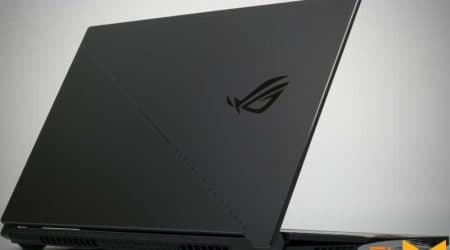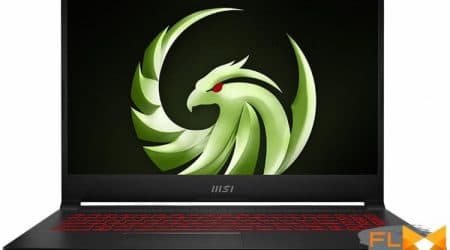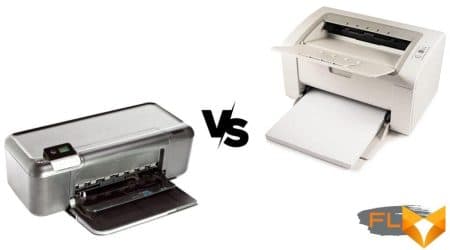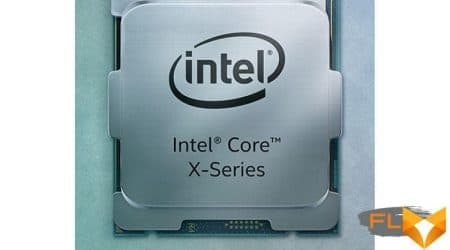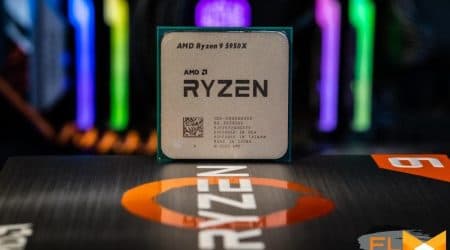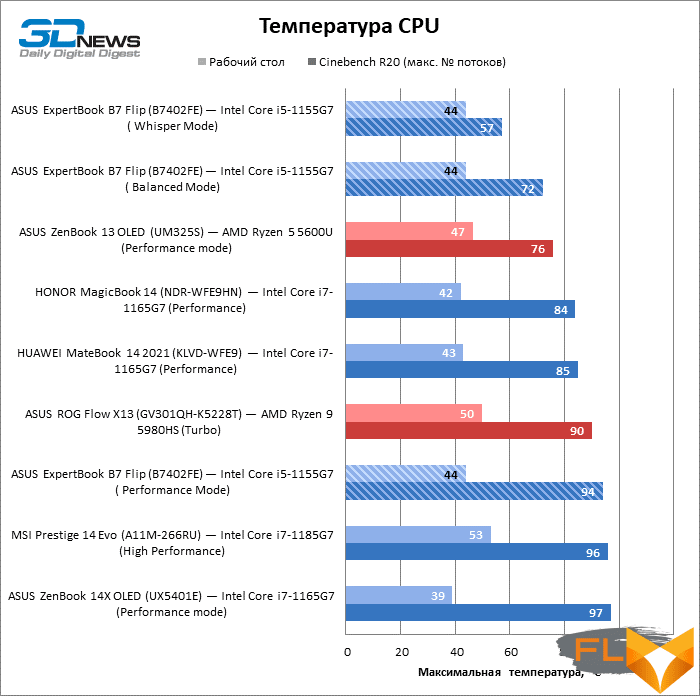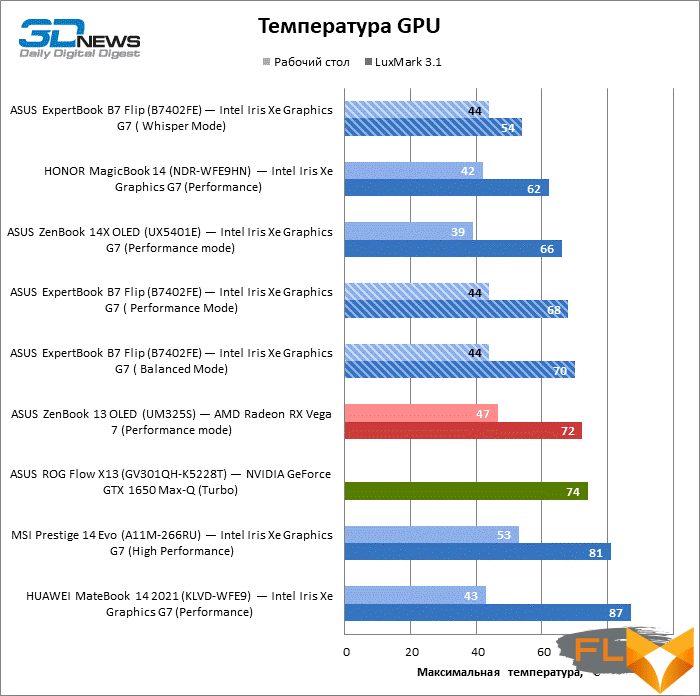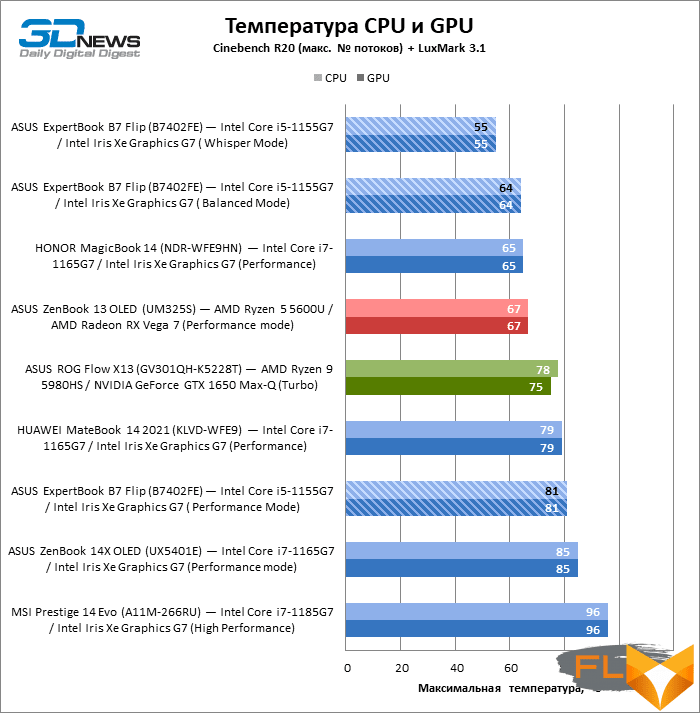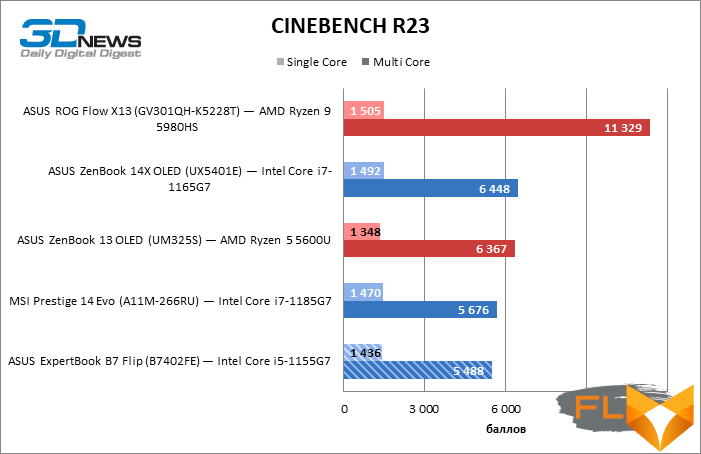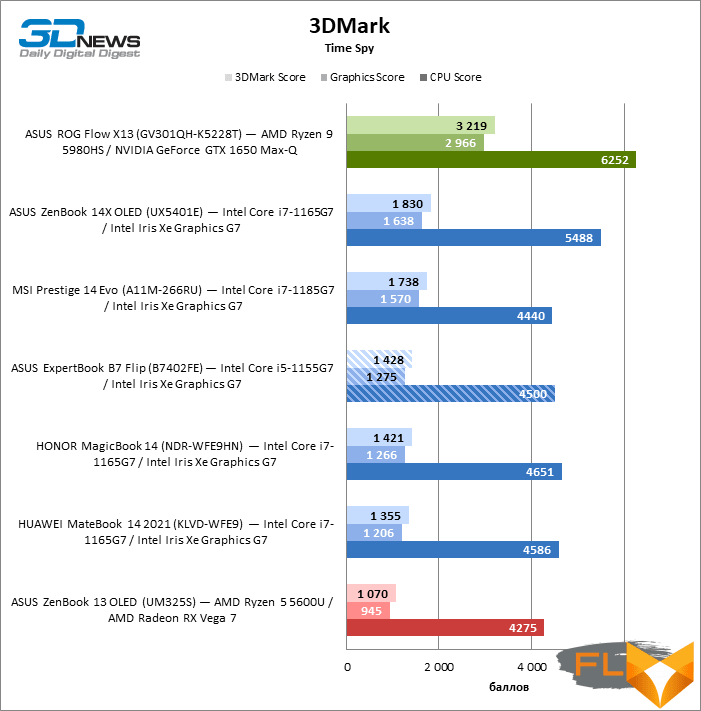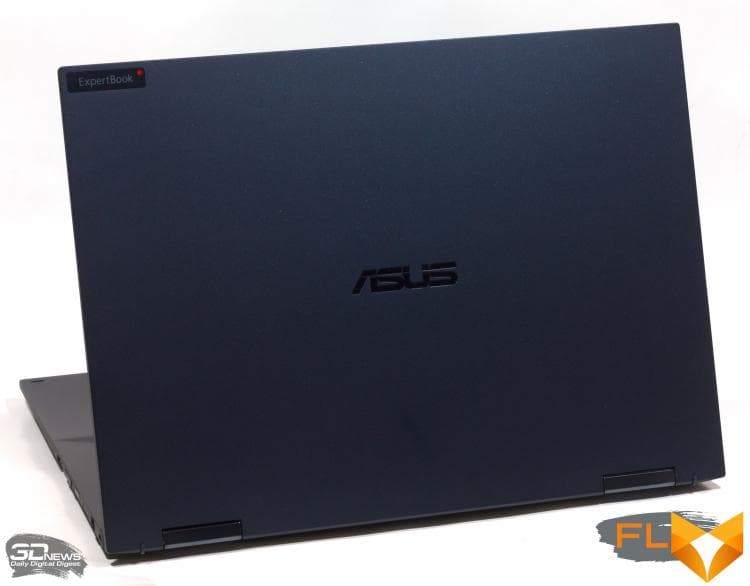


The ExpertBook line, which was born a couple of years ago, is focused more on the business public than on ordinary users. This means that the compactness and high-performance filling inherent in any modern ultrabook is no longer enough for the products of the Taiwanese company to compete on an equal footing with products of brands that have long been rooted in this area. ASUS is well aware of this, and each next iteration of the ExpertBook represents a major step forward. We have not touched these devices since the beginning of 2021, when the ExpertBook B9 (B9400CEA) review came out, and today the fresh ExpertBook B7 Flip is on the agenda. Although the novelty is based on the same generation of Intel processors with a Tiger Lake core, the ExpertBook B7 Flip definitely outperforms its relative in terms of richness of functions and is at least as good as what competing brands can offer.
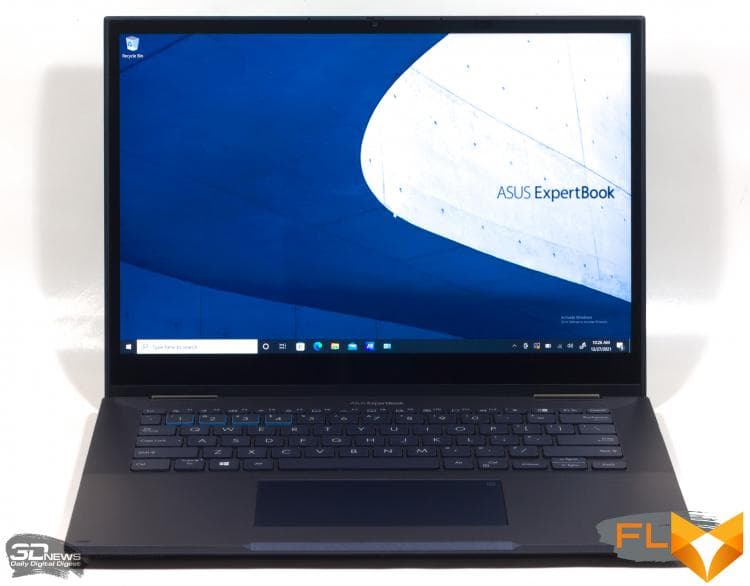
⇡#Specifications, prices
In the main specifications, the ExpertBook B7 Flip is quite a typical ultrabook of the current generation based on the Intel Tiger Lake platform. Although Intel cannot yet offer the same number of x86 cores as the “red” low-wattage CPUs in the energy-efficient category, ASUS has chosen two chips that differentiate ExpertBook B7 Flip configurations well in terms of performance: Core i7-1195G7 is the top model among all Tiger Lake class UP3 – and Core i5-1155G7. However, since both processors have four x86 cores with SMT support, the key differences between them come down to clock speeds (up to 5 GHz for Core i7 and 4.5 GHz for Core i5), L3 cache (12 and 8 MB respectively) as well as a set of Intel Xe integrated graphics compute units (96 and 80). Well, the more interesting it will be to find out whether the choice of the buyer in favor of the Core i5 will turn out to be a big compromise in the speed of performing resource-intensive tasks, because we have not yet come across Core i5-based ultrabooks with a Tiger Lake core (solid Core i7), and the ExpertBook test sample B7 Flip is equipped with just such a CPU.
The ExpertBook B7 Flip does not have a discrete GPU. But it is possible to increase the amount of RAM by the user: from 32 GB, which is the limit of the laptop’s factory configuration, to 64. But modern compact machines, due to the widespread use of LPDDR4X type chips, are less and less likely to upgrade RAM. As a drive, ASUS uses an SSD from 256 GB to 1 TB, and on the fourth-generation high-speed PCI Express bus, which, unlike the Ryzen 5000 series chips, Tiger Lake silicon can work with.
The laptop is equipped with a 14-inch screen with a convenient 16:10 aspect ratio and a resolution of 1920 × 1200 or 2560 × 1600. Since this is a 2-in-1 device that combines the functions of a laptop and a tablet, its display recognizes the touch of fingers or a stylus. Optionally, a screen with a “safe” coating is offered, limiting viewing angles in order to hide sensitive information from prying eyes.
| Manufacturer | ASUS |
|---|---|
| Model | ExpertBook B7 Flip (B7402FE) |
| Display | 14”, 1920 × 1200, IPS, touch; 14”, 2560 × 1600, IPS, touch |
| CPU | Intel Core i5-1155G7 (4/8 cores/threads, 2.5-4.5GHz); Intel Core i7-1195G7 (4/8 cores/threads, 2.9-5.0 GHz) |
| RAM | DDR4 SDRAM, 3200 MT/s, 8-32 GB (two channels) |
| GPU | Intel Iris Xe Graphics G7 (system memory) |
| Accumulator | SSD (PCIe 4.0 x4) 256GB-1024GB |
| External I/O connectors | 2 × USB 3.2 Gen 2 Type-A; 2 x Thunderbolt 4/USB4/DisplayPort; 1 x Mini Display Port; 1 x HDMI; 1 × smart card reader; 1 x TRS 3.5mm |
| Network | Gigabit Ethernet (Micro HDMI to RJ-45); IEEE 802.11ax; Bluetooth 5.2; LTE/5G |
| Battery capacity, Wh | 63 |
| Weight, kg | 1.43–1.44 |
| Overall dimensions (L × W × H), mm | 320 × 234 × 18–18.9 |
| USD retail price | 1500+ (Intel Core i5-1155G7, 16GB RAM, 512GB SSD, 2560×1600) |
ExpertBook B7 Flip, regardless of the chosen configuration, has a number of features that do not allow this machine to be cheap. Nevertheless, you can’t call it overly expensive either. While working on the review, we found an offer with features that most users would like (Core i5-1155G7, 16 GB RAM, 512 GB SSD and 2560 × 1600 screen resolution) for a price of just under $1500.
⇡#Look and feel
Due to the fact that the ExpertBook B7 Flip is a convertible laptop, it weighs more than machines with similar fillings that cannot work in tablet mode: 1.43-1.44 kg, depending on the configuration. The maximum thickness of the laptop when the lid is down is 19mm, enough to leave room on the sides of the chassis for numerous wired interfaces.
All body panels of the ExpertBook B7 Flip (with the exception of the radio-transparent inserts at the bottom where the antennas are located) are thin-walled, made of magnesium-aluminum alloy, but due to the internal struts and the mass of screws, we managed to make the chassis quite durable. This is confirmed by the US military standard certification for environmental resistance MIL-STD 810H, as well as a number of additional tests that ASUS conducted independently.
The metal is covered with a dark gray-blue paint with a deep matte, embossed texture (often referred to as “moiré”) and small crumbs that barely glisten in the side light. The surface is pleasant to the touch and perfectly resists the appearance of greasy fingerprints.

The screen, like all modern transformers, is laminated with glass, but here it is not glossy, as usual, but matte and, therefore, glare is much less. Instead of fingers on the screen, you can use the pen ASUS PEN SA201H, which is compatible with the MPP 2.0 standard, which means that it recognizes not only 4096 degrees of pressure, but also the angle of inclination. True, this is an optional accessory that is not included in the ExpertBook B7 Flip package.
Despite the screen aspect ratio of 16:10, we still had to make a high indent from the bottom of the panel, and in general, the frames around the screen look quite wide by the standards of modern ultrabooks. The peephole of a conventional webcam with a mechanical shutter is integrated into the top frame, as well as an IR camera for biometric authentication in Windows.
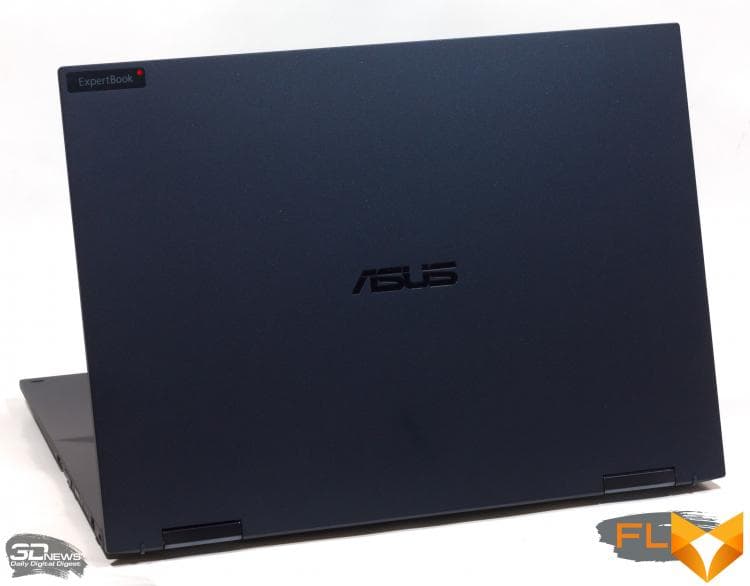
There is an unusual element on the back of the lid on the top corner — a red LED that signals to colleagues that the user of the ExpertBook B7 Flip asks not to distract him. The LED turns on either automatically when a video conference is in progress, or manually by pressing a hot key. The cover itself is easily lifted with one hand, and its back edge serves as a support for the laptop in the working position, lifting the bottom above the table.
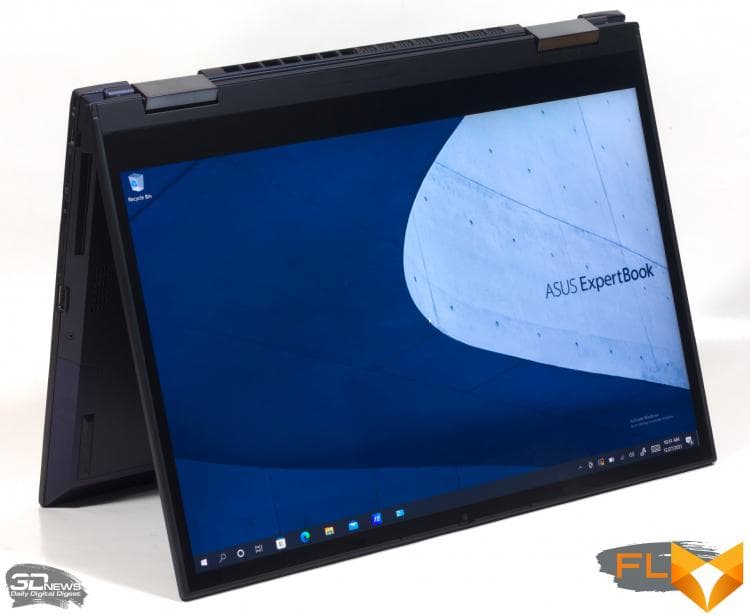
The ExpertBook B7 Flip keyboard is similar in mechanics to the controls of ASUS ZenBook series laptops. The keys have a fairly long travel, and the base under them does not flex as easily as we would expect from a device in a thin-walled case. However, you can wish that in their future work laptops ASUS made the moment of operation of the mechanisms more clear. In addition, due to the design of the chassis, the keyboard drums quite loudly during typing.
With a screen size of 14 inches, it was possible to expand the keyboard with an additional row, which, however, is absent in the ExpertBook B7 Flip. But the existing keys turned out to be wide, not counting the “~”. Numeric keys from “1” to “4” are framed: you can bind arbitrary combinations to them with the Fn key – turn Bluetooth on / off, open a specific folder in Explorer, etc. The combination “Fn + 1” controls red by default indicator on the lid of the laptop. The keyboard backlight is white, single-stage. And most importantly, the keyboard provides a certain degree of protection against moisture and, according to the manufacturer, up to 78 ml of liquid can be poured onto it without any consequences.
The free space around the touchpad shows that it could also easily be made larger. Nevertheless, even now its area is quite enough for comfortable work. The touchpad is covered with glass, and the mechanics of the switches do not cause any complaints. A long touch on the symbol in the upper right corner of the panel activates a special “chip” of ASUS laptops – a luminous marking of the digital block, which does not interfere with the use of the touchpad for its intended purpose. But, unlike the ZenBook, the ExpertBook B7 Flip’s markup is not white, but blue and designed differently.
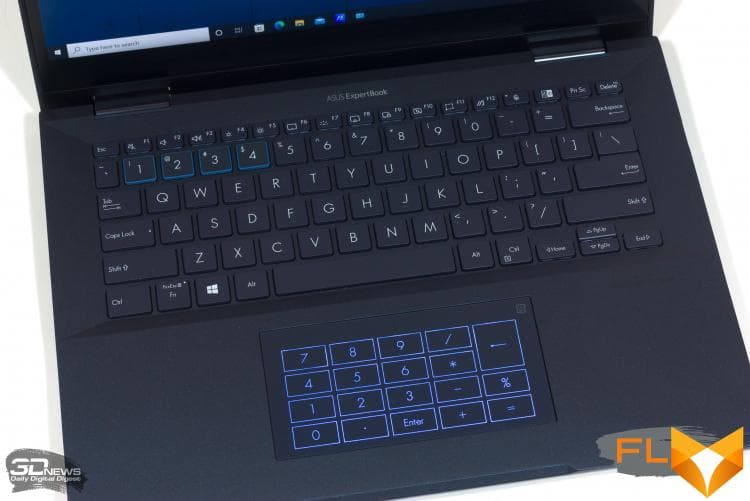
ExpertBook B7 Flip has a full set of authentication tools: by infrared camera or fingerprint (the sensor is integrated into the power button on the right side), and also using smart cards (the reader slot occupies minimum usable space under a number of other connectors).
No less rich set of wired interfaces. The main standard for the ExpertBook B7 Flip is Thunderbolt 4, compatible with USB4: through these two connectors, the laptop both charges and transmits a DisplayPort signal. They are complemented by a single USB 3.2 Gen 2 type A port, full-length HDMI, and a separate Mini DisplayPort. Do not forget the mini-jack for audio devices, by the way, the sound volume is regulated by a physical “rocker”. The laptop can be connected to a wired LAN using an adapter via the Mini HDMI connector (like the stylus, the adapter is not included). And most importantly, there are ExpertBook B7 Flip configurations with a built-in LTE / 5G modem (the laptop that was sent to us for testing does not have a modem, but still has a SIM card tray). Against the backdrop of all this abundance, only a memory card reader is missing.
Dotted LED indicators for power and battery charge are also located on the side of the device, where they are not conspicuous.

The laptop battery is charged from a custom 65W power supply with an extension cable for a standard three-pin connector. The only pity is that when working from the network, the PSU occupies one USB port, of which there are already only three.
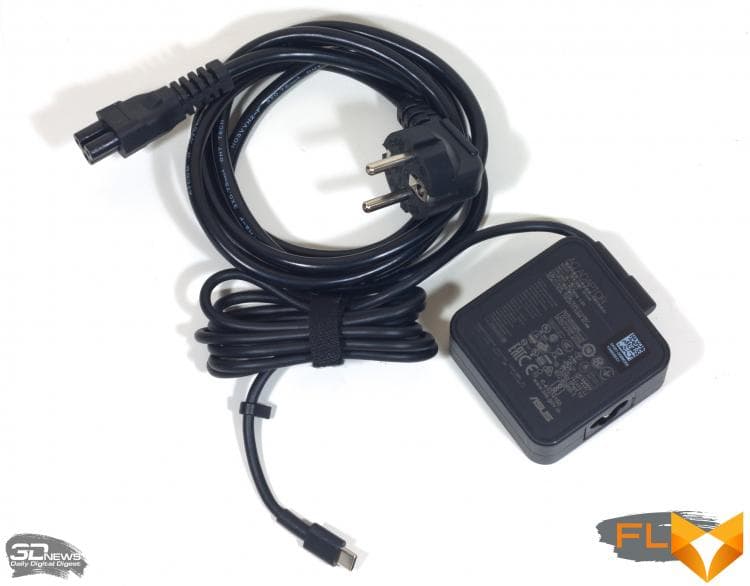
⇡#Internal design and upgrade options
Inside the ExpertBook B7 Flip is not quite usual. The cooling system works in a standard way – cold air enters through the perforation in the bottom of the case, and hot air is thrown into the gap between the keyboard and the screen – but the fan shroud is made of metal, and thus it is also part of the radiator. Three heat pipes go from the heat sink of the central processor to the radiator.

As we have already noticed, this laptop allows you to expand the RAM by replacing DDR4 modules, which is not immediately noticeable upon opening, since the SO-DIMM slots are covered with a metal cover. In our copy of the ExpertBook B7 Flip, the modules have an unequal size – 16 and 8 GB – but this is a feature of the test sample. The black plate in the upper left corner is a smart card reader assembled on a separate printed circuit board. Below it, where the tails of unused antennas fit, the place of the LTE / 5G modem is empty.
|
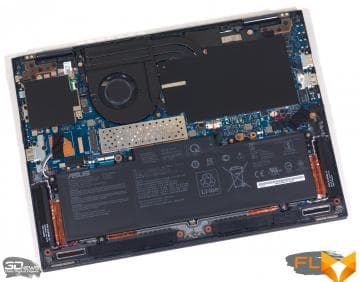 |
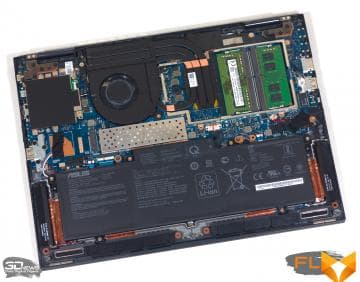 |
Also note that the ports of external interfaces are attached to the PCB with brackets on two or three screws to protect the board from damage in case of careless handling.
All configurations of the ExpertBook B7 Flip are equipped with batteries of the same capacity – 63 Wh.
⇡#Test Methodology
| Synthetic tests | |
|---|---|
| Application | Settings |
| 3DMark Time Spy | — |
| Geekbench 5 | — |
| CINEBENCH R23 | — |
| GFXBench 5 (Aztec Ruins — Normal Tier, High Tier) | Windows: Vulkan, macOS: Metal |
| fio 3.16 | Sequential read/write, random read/write (unbuffered I/O) |
| Work Applications | |||||
|---|---|---|---|---|---|
| Application | Benchmark | Settings/Notes | API | ||
| Intel Graphics | AMD Graphics | NVIDIA Graphics | |||
| Adobe Photoshop 2021 (22.4) | PugetBench for Photoshop 0.93 (list of tests here) | — | OpenGL + OpenCL + Metal (macOS) | OpenGL + OpenCL + Metal (macOS) | OpenGL + OpenCL |
| Adobe Photoshop Lightroom Classic 10.2 | PugetBench for Lightroom Classic 0.92 (list of tests here) | — | DirectX 12 (Windows) | DirectX 12 (Windows) | DirectX 12 |
| Adobe Premiere Pro 2021 (15.0) | PugetBench for Premiere Pro V0.95.1 (composition of tests at the link) | Standard Benchmark (4K) | OpenCL (Windows)/Metal (macOS) | OpenCL (Windows)/Metal (macOS) | CUDA |
| Blender 2.9x | Class Room demo from Blender Foundation | Cycles renderer. Feature Set: Supported. Tile size: 32 × 32 (CPU) or 256 × 256 (GPU) | N/A (CPU rendering) | OpenCL (Windows)/CPU (macOS) | CUDA/OptX |
Display testing is performed using the X-Rite i1Display Pro Plus colorimeter in the DisplayCAL 3 application.
Notebook battery life is measured at a display brightness of 200 cd/m2 in the following usage scenarios:
- web surfing: alternately opening and closing tabs of Computeruniverse.ru and Unsplash.com sites with an interval of 25 seconds in the Google Chrome browser (cache and cookies are disabled);
- Continuous playback of 4K HEVC (H.265) video.
⇡#Test participants
The following devices took part in testing:
| Screen | CPU | RAM | GPU | SSD | HDD | Battery | |||
|---|---|---|---|---|---|---|---|---|---|
| ASUS ExpertBook B7 Flip (B7402FE) | 14”, 2560 × 1600, IPS | Intel Core i5-1155G7 | 4/8 cores/threads, 2.5-4.5GHz | DDR4 SDRAM, 3200 MT/s, 24 GB | Intel Iris Xe Graphics G7 | 1 GB from system memory | Samsung PM9A1 (PCIe 4.0 x4) 512 GB | None | 63 Wh |
| ASUS ROG Flow X13 (GV301QH-K5228T) | 13.4”, 3840 × 2400, IPS | AMD Ryzen 9 5980HS | 8/16 cores/threads, 3.1-4.8GHz | LPDDR4X SDRAM, 4266 MT/s, 32 GB | NVIDIA GeForce GTX 1650 Max-Q | 4GB GDDR6 | WD PC SN530 (PCIe 3.0 x4) 1024 GB | None | 62 Wh |
| ASUS ZenBook 13 OLED (UM325S) | 13,3”, 1920 × 1080, OLED | AMD Ryzen 5 5600U | 6/12 cores/threads, 2.3-4.2 GHz | LPDDR4X SDRAM, 4266 MT/s, 16 GB | AMD Radeon RX Vega 7 | 512MB of system RAM | SK Hynix PC711 (PCIe 3.0 x4) 512 GB | None | 67 Wh |
| ASUS ZenBook 14X OLED (UX5401E) | 14”, 2880 × 1800, OLED | Intel Core i7-1165G7 | 4/8 cores/threads, 2.8-4.7GHz | LPDDR4X SDRAM, 4266 MT/s, 16 GB | Intel Iris Xe Graphics G7 | 1 GB from system memory | Samsung PM9A1 (PCIe 4.0 x4) 1024 GB | None | 63 Wh |
| HONOR MagicBook 14 (NDR-WFE9HN) | 14″, 1920 × 1080, IPS | Intel Core i7-1165G7 | 4/8 cores/threads, 2.8-4.7GHz | DDR4 SDRAM, 3200 MT/s, 16 GB | Intel Iris Xe Graphics G7 | 1 GB from system memory | WD PC SN730 (PCIe 3.0 x4) 512GB | None | 56 Wh |
| HUAWEI MateBook 14 2021 (KLVD-WFE9) | 14″, 2160 × 1440, IPS | Intel Core i7-1165G7 | 4/8 cores/threads, 2.8-4.7GHz | DDR4 SDRAM, 3200 MT/s, 16 GB | Intel Iris Xe Graphics G7 | 1 GB from system memory | WD PC SN730 (PCIe 3.0 x4) 512GB | None | 56 Wh |
| MSI Prestige 14 Evo (A11M-266RU) | 14″, 1920 × 1080, IPS | Intel Core i7-1185G7 | 4/8 cores/threads, 3.0-4.8GHz | LPDDR4X SDRAM, 4266 MT/s, 16 GB | Intel Iris Xe Graphics G7 | 1 GB from system memory | Phison 1TB SM2801T24GKBB4S-E162 (PCIe 4.0 x4) 1024 GB | None | 52 Wh |
⇡#Screen Quality
The ExpertBook B7 Flip comes with either a 1920 x 1200 or 2560 x 1600 resolution. Our test unit had the second option installed and we can assure you it’s a superior screen in every way. It has a high contrast ratio – 1400:1 and, despite the high pixel density, an impressive margin of brightness – 428 cd/m2.
The matrix does not have an extended color gamut, however, if the user does not process photos or videos in professional software, the extended color gamut for Windows systems (an OS lacking an end-to-end color management system) is more likely to harm than help. And the sRGB space of the ASUS laptop screen covers almost entirely.
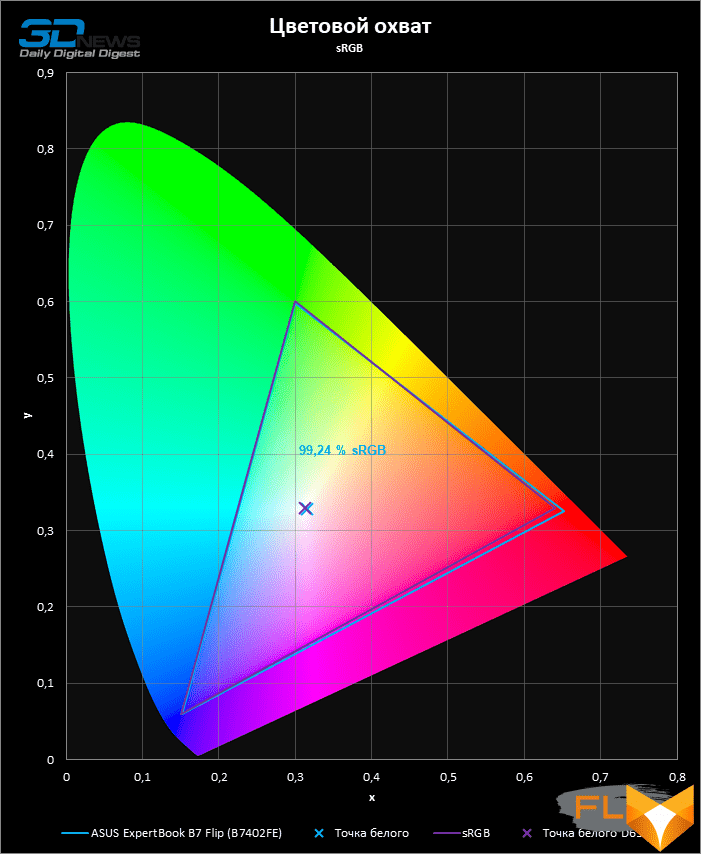
The color temperature, clearly set at 6500K, shows that the panel has been factory calibrated.
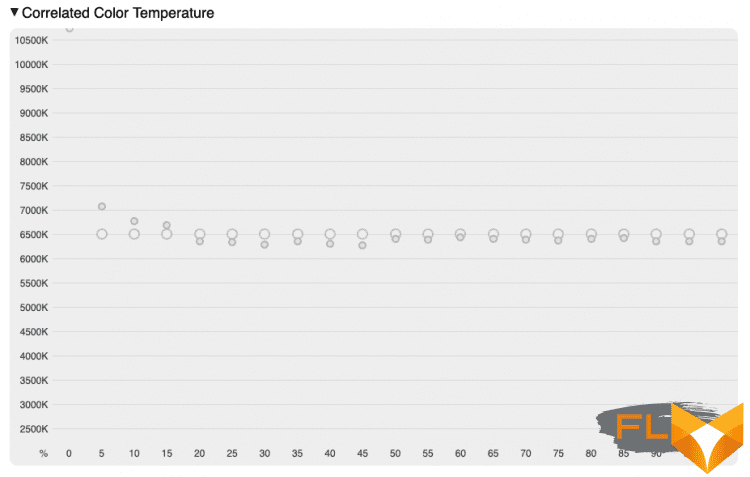
The gamma correction curve almost perfectly matches the curve laid down in the sRGB specification. There are questions only to the gray balance.
 | 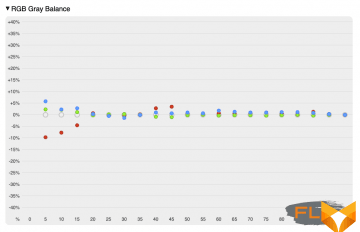 |
Nevertheless, the screen showed high color fidelity even by professional criteria, which is rare for laptops that do not belong to the class of mobile workstations. As a result, although the manufacturer did not provide the ExpertBook B7 Flip with a profile describing the display parameters, there is no need for it: you can expect that even without additional profiling, the screen complies with the sRGB standard.
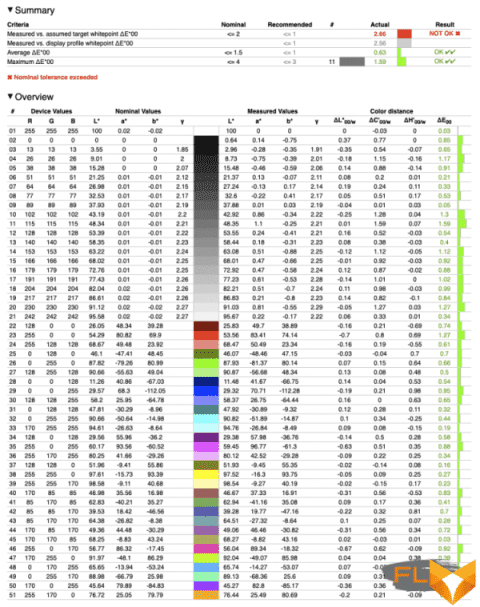
⇡#Clock speeds, temperature and noise level
The Core i5-1155G7 CPU found in our ExpertBook B7 Flip sample utilizes the full 28W headroom of the UP3-class power-saving Tiger Lake chips by activating “performance” mode in the MyASUS control software, and supports clock speeds up to 3 .3 GHz when four cores are fully loaded. Intel XE Integrated Graphics runs at its typical 1.35 GHz frequency. When the CPU and GPU of the system-on-a-chip are fully loaded at the same time, the speed of the video core hardly suffers, but the x86 cores slow down to 2.5 GHz – this is a typical behavior for laptops on the Intel platform.
Switching to Balanced mode limits the power consumption of the crystal to 18W and thus reduces the sustained CPU clock speeds to 2.6GHz in intensive multi-threaded tasks, and to 1.8GHz when running alongside the GPU. Well, the Whisper mode sets the TDP at 10W, and the x86 core clock speed barely exceeds 1.6 GHz even with an isolated load and drops to 0.8 GHz when work is being done on the GPU at the same time (the GPU itself is also content with a low frequency in such conditions about 0.46 GHz).
| Clock speeds under load | ||||||||
|---|---|---|---|---|---|---|---|---|
| Cinebench R20 (Max Thread #) | LuxMark 3.1 | Cinebench R20 (Max Thread #) + LuxMark 3.1 | ||||||
| CPU clock speed, MHz | GPU clock speed, MHz | CPU clock speed, MHz | GPU clock speed, MHz | |||||
| Medium | Max | Medium | Max | Medium | Max | Medium | Max | |
| ASUS ExpertBook B7 Flip (B7402FE) – Intel Core i5-1155G7 / Intel Iris Xe Graphics G7 – Performance Mode | 3270 | 3493 | 1355 | 1360 | 2454 | 2495 | 1343 | 1352 |
| ASUS ExpertBook B7 Flip (B7402FE) – Intel Core i5-1155G7 / Intel Iris Xe Graphics G7 – Balanced Mode | 2625 | 2794 | 1347 | 1356 | 1776 | 1971 | 1011 | 1148 |
| ASUS ExpertBook B7 Flip (B7402FE) – Intel Core i5-1155G7 / Intel Iris Xe Graphics G7 – Whisper Mode | 1613 | 1797 | 739 | 754 | 790 | 901 | 460 | 503 |
| Power consumption of CPU and GPU | ||||||||
|---|---|---|---|---|---|---|---|---|
| Cinebench R20 (Max Thread #) | LuxMark 3.1 | Cinebench R20 (Max Thread #) + LuxMark 3.1 | ||||||
| CPU power consumption, W | GPU power consumption (SoC as a whole, if integrated), W | CPU power consumption, W | GPU power consumption (if discrete), W | |||||
| Medium | Max | Medium | Max | Medium | Max | Medium | Max | |
| ASUS ExpertBook B7 Flip (B7402FE) – Intel Core i5-1155G7 / Intel Iris Xe Graphics G7 – Performance Mode | 28 | 29 | 16 | 18 | 25 | 26 | N/A | N/A |
| ASUS ExpertBook B7 Flip (B7402FE) – Intel Core i5-1155G7 / Intel Iris Xe Graphics G7 – Balanced Mode | 18 | 19 | 18 | 18 | 16 | 17 | N/A | N/A |
| ASUS ExpertBook B7 Flip (B7402FE) – Intel Core i5-1155G7 / Intel Iris Xe Graphics G7 – Whisper Mode | 10 | 11 | 8 | 9 | 9 | 10 | N/A | N/A |
Note The measurement is performed after the device has warmed up and all parameters have stabilized.
Despite the curious design of the ExpertBook B7 Flip cooling system, heat dissipation from the Tiger Lake chip operating at full power is difficult for her: in Performance mode, the temperature of the crystal reaches 94 ° C, which, however, is acceptable at least for intermittent loads, and you can’t say the same about the noise level of 45 dBA. Fortunately, the Balanced mode reduces heat to 72°C and noise to 39dBA, while the Whisper setting drops to 57°C and 26dBA. Regardless of the selected power mode, the laptop cooler runs almost silently when the SoC is idle.
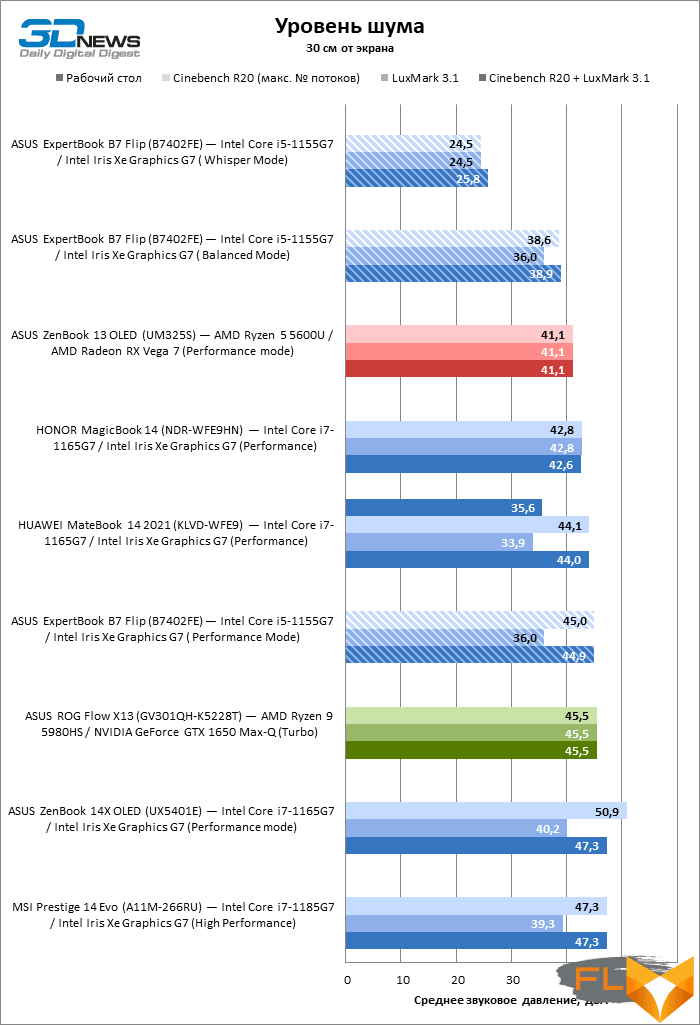
⇡#Synthetic performance tests
Since the main material for comparison with the ExpertBook B7 Flip are laptops based on Intel’s Core i7 processors, and the test sample of the novelty contains a Core i5 chip of the same architecture, synthetic benchmarks immediately found a difference in performance between them. True, it occurs mainly in multi-threaded mode and reaches significant values only for certain types of load. However, this is enough for the Core i5 to give way to six-core AMD, with which the Core i7 competes not without success.
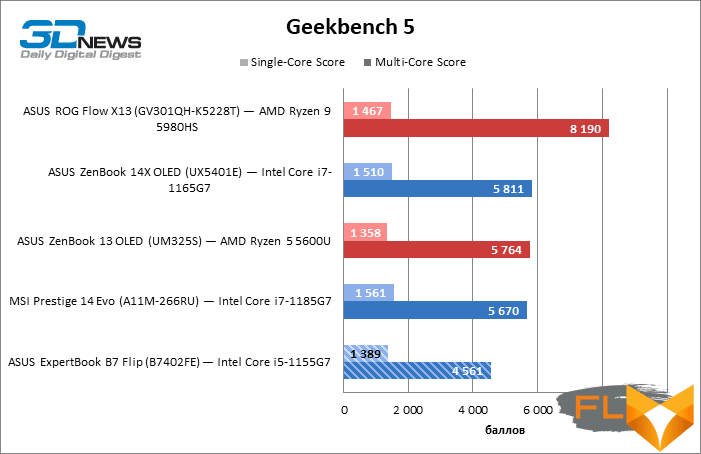
As for the Intel Xe graphics integrated into the Core i5, the lag in the number of computing units from the Core i7 video core is most often imperceptible, and compared to the built-in GPU of the Ryzen 5000 processors, the Intel solution wins in any case.
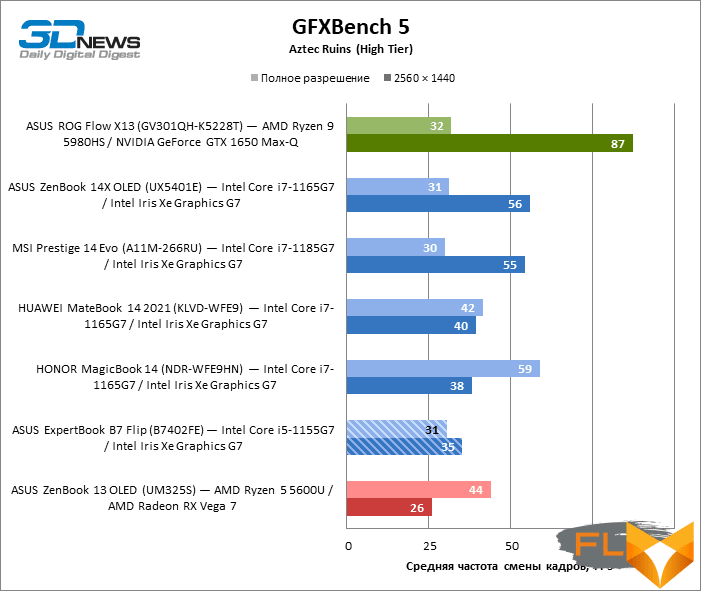
⇡#Performance in production applications
When rendered in Blender by the CPU, the Core i5 chip inside the ExpertBook B7 Flip is as good as most Core i7 variants, except for those that have been overclocked by increasing the headroom, but can no longer compete with six- and eight-core “red” CPUs.
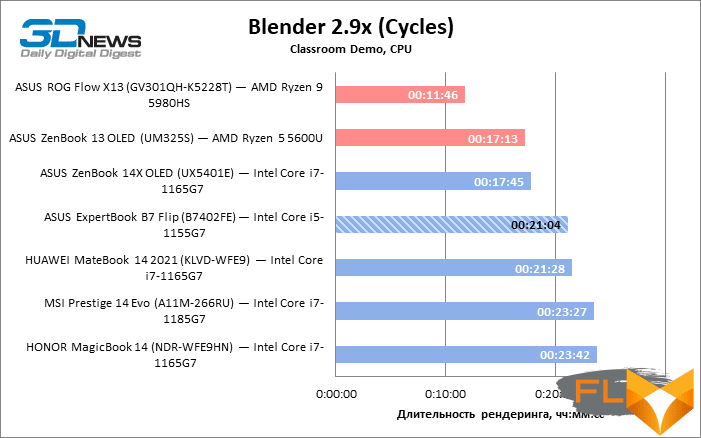
The performance of Intel Xe graphics of certain laptops in the same task is rather unpredictable, and ExpertBook B7 Flip, oddly enough, belongs to one of the best results, although the transfer of load from the CPU to the GPU gives only a small gain in rendering time.

In the Lightroom Classic benchmark, most laptops based on Intel’s Tiger Lake platform show similar results and outperform the six-core “red” solutions, at least in the speed of passive tasks. The Core i5 here is inferior to the Core i7 only in active tasks, but it copes with them no worse than the six-core Ryzen 5 5600U.
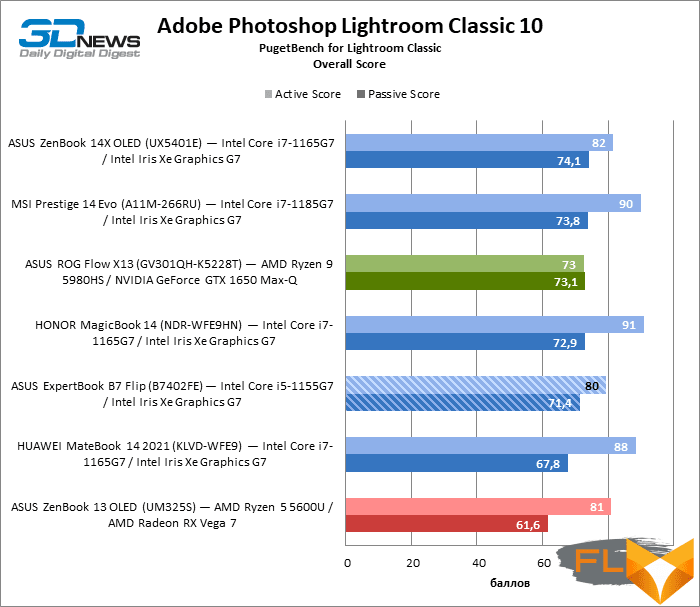
Note Scores are calculated as a percentage of Intel Reference Workstation performance Core i9-9900K, NVIDIA GeForce RTX 2080, 64GB RAM.
As for Photoshop, the ExpertBook B7 Flip is indistinguishable from Core i7-based machines in terms of overall performance. Only the absence of a discrete graphics processor in the ASUS laptop is clearly visible.
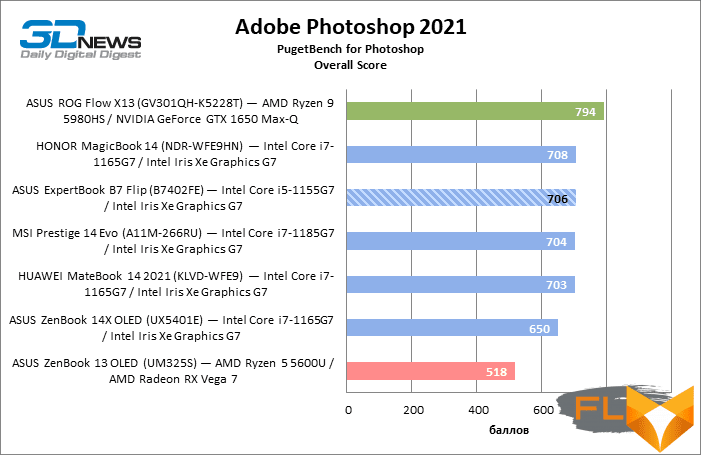
Note Scores are calculated as a percentage of Intel Reference Workstation performance Core i9-9900K, NVIDIA GeForce RTX 2080 and 64GB RAM x 10.
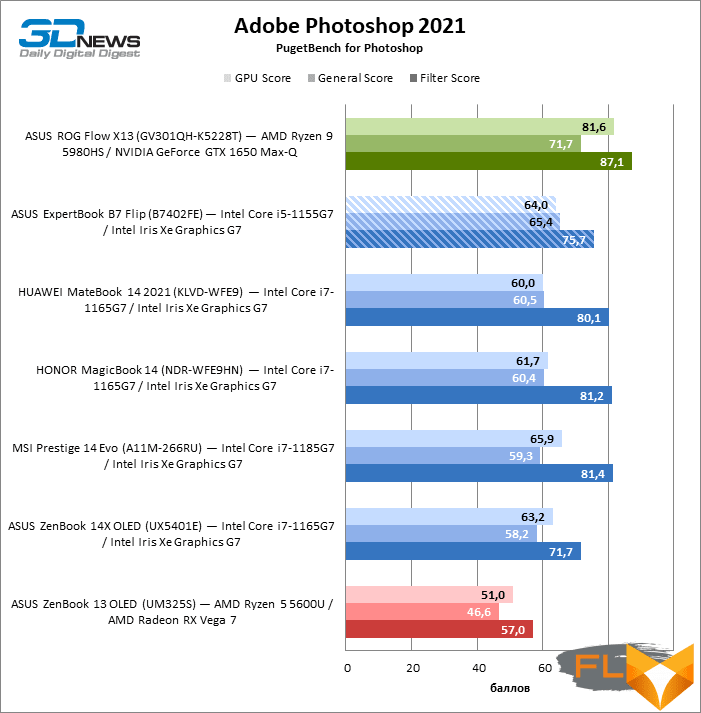
Note Scores are calculated as a percentage of Intel Reference Workstation performance Core i9-9900K, NVIDIA GeForce RTX 2080, 64GB RAM.
The ExpertBook B7 Flip laptop in a Core i5 configuration is poorly adapted to work in Premiere Pro, even if it outperforms a machine based on a six-core Ryzen in terms of the overall score of the test package. However, often the Core i7 is not able to significantly increase performance – it depends much more on the CPU’s power reserve. Processors overclocked by TDP and, of course, machines with a discrete GPU are out of competition here.
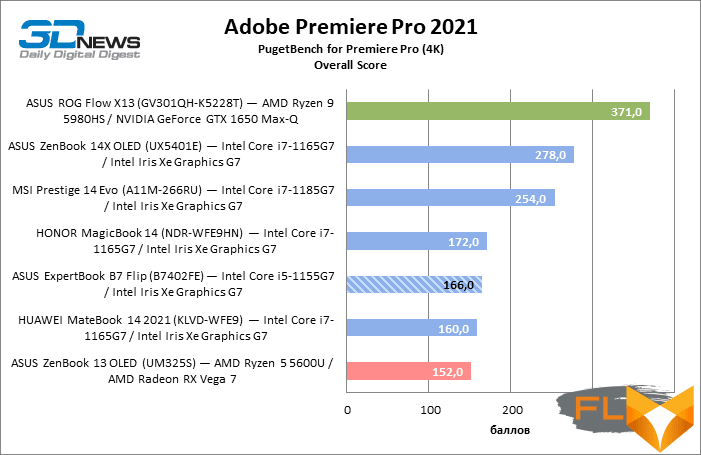
Note Scores are calculated as a percentage of AMD reference workstation performance Ryzen 9 5900X, NVIDIA GeForce RTX 3080 and 64GB RAM x 10.
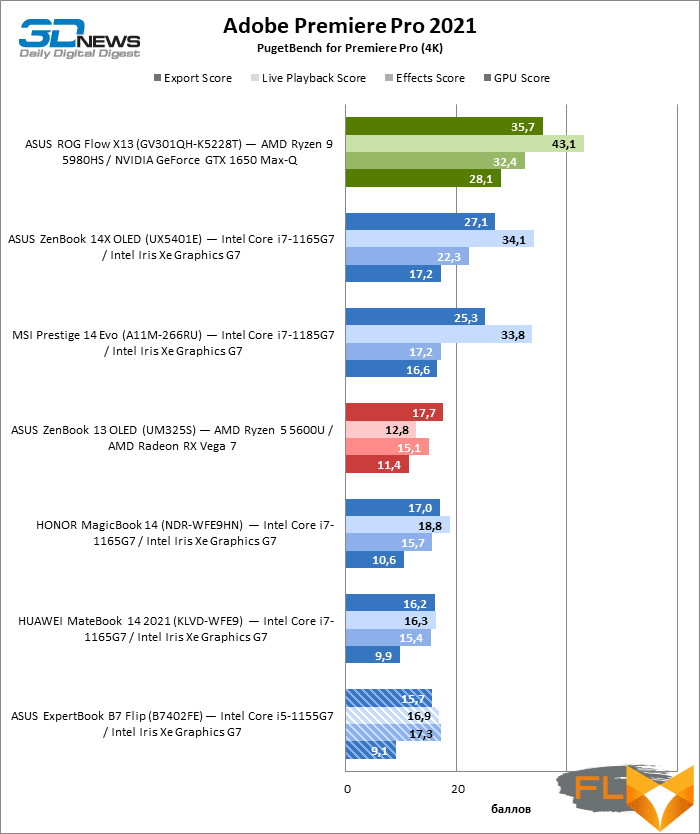
Note Scores are calculated as a percentage of AMD reference workstation performance Ryzen 9 5900X, NVIDIA GeForce RTX 3080, 64GB RAM.
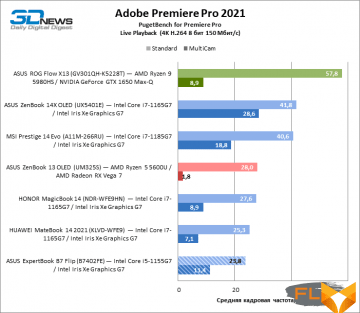 |  |
⇡# SSD Performance
The Samsung PM9A1 solid state drive is already familiar to us. With a 4th generation PCI Express interface, this SSD achieves linear read speeds in excess of 5500MB/s. But, as it turned out, only varieties of PM9A1 with a capacity of at least 1 TB are capable of this, and our ExpertBook B7 Flip sample has only 512 GB of ROM. Because of this, sequential read throughput no longer stands out from the results of other SSDs that are often found in ultrabooks. But the sequential write speed is still very high – up to 3200 MB / s with a fairly long command queue. The volume – 512 or 1024 GB – did not affect the performance of the SSD during random reading and writing blocks, but it was already rather mediocre.
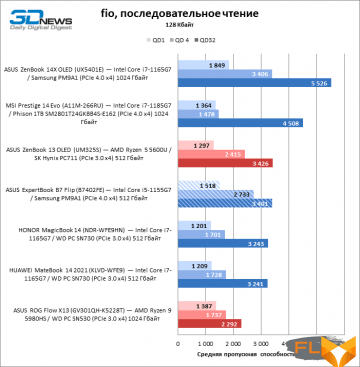 | 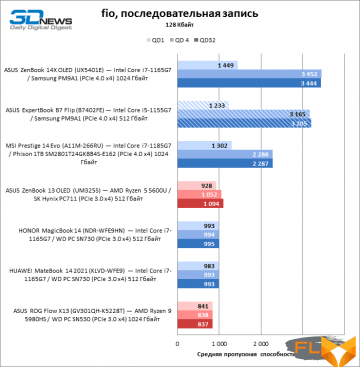 | |
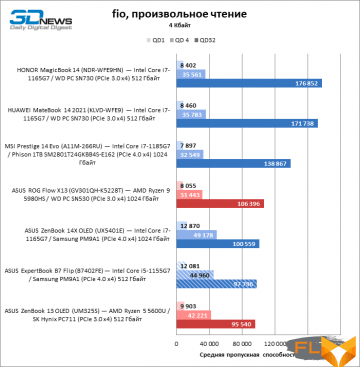 | 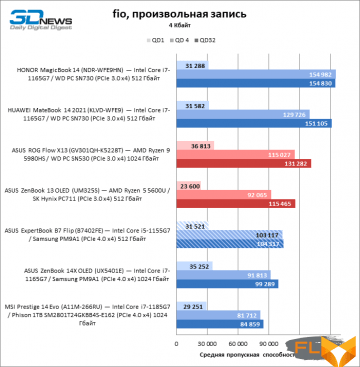 |
⇡# Battery life
In terms of battery life, the ExpertBook B7 Flip does not stand out from the general range of devices with similar components and screen size: a little more than six hours of continuous web surfing or 7 hours and 48 minutes of watching HEVC video. True, the ExpertBook B7 Flip shows such results in the low power consumption mode (Whisper Mode) and with the screen brightness set at 200 cd/m2.
⇡#Conclusions
The new ExpertBook B7 Flip satisfies, perhaps, all possible requirements for a working laptop. It has three authentication methods at once – a fingerprint scanner, an IR camera and a smart card reader, a wide range of interfaces, including a wired network (via an adapter) and even a built-in LTE / 5G modem. Of the security features, we highlight the webcam shutter and an optional screen with limited viewing angles. By the way, the screen of the ExpertBook B7 Flip is simply wonderful – with high brightness, contrast, excellent color reproduction and, unlike the screens of other transformers, a matte finish. And its main advantage is a convenient aspect ratio of 16:10. We also note such a rare feature in our time as protection of the keyboard from leaks.
As for the main stuffing of the laptop, it is the same as in most modern machines based on low-wattage Intel CPUs of the Tiger Lake family. Luckily, we tested a configuration with a Core i5 processor (usually you have to deal with a Core i7 of the same series) and can assure that most users of the machine are unlikely to notice the difference between the two chips. Greater performance could be achieved by increasing the CPU power reserve, but the cooling system of the ExpertBook B7 Flip is definitely not designed for such experiments. Unfortunately, there is no alternative version of the laptop with Ryzen chips either. But it is possible to change the RAM modules, which thin ultrabooks are gradually losing.
It’s hard to find any obvious flaw in the ExpertBook B7 Flip. However, someone will not like not the narrowest bezels around the screen by modern standards or the absence of a number of additional keys. Well, even though the laptop has a fairly solid case, there is still a lack of rigidity under the keyboard, and the mechanics of the ASUS keys are also worth working on. But, we repeat, for business tasks, the ExpertBook B7 Flip has an almost exhaustive set of qualities that are not found simultaneously in “home” models, but cost about the same money.
FAQ Asus expertbook b7 flip (b7402fe)
What is the advantage of having Windows 11 on an ASUS laptop for business users?
Windows 11 offers a streamlined and efficient work environment, catering specifically to the needs of business users with its advanced features and user-friendly interface.
How does the manual check repair status feature in MyASUS enhance the user experience?
The manuals check repair status feature in MyASUS allows users to easily track the repair process of their device, ensuring transparency and convenience in service management.
What benefits does Wi-Fi 6 bring to ASUS laptops?
Wi-Fi 6 provides a faster and more reliable internet connection, significantly enhancing online activities such as streaming, downloading, and conference calls.
Why are two Thunderbolt 4 ports important in ASUS laptops?
Having two Thunderbolt 4 ports enables lightning-fast data connections and the ability to connect multiple external devices, offering flexibility and high performance for demanding tasks.
How does Windows Hello improve security on ASUS laptops?
Windows Hello offers enterprise-grade security by allowing biometric authentication, ensuring that only authorized users can access the laptop.
What are the benefits of the 12th Gen Intel Core i7-1195G7 processor in ASUS laptops?
The latest 12th Gen Intel Core i7-1195G7 processor delivers exceptional speed and efficiency, making it ideal for multitasking and handling complex business applications.
Can you describe the ASUS Private View feature?
ASUS Private View is an optional feature that enhances privacy by narrowing the viewing angle of the screen, ensuring that sensitive information is visible only to the user.
Is touchscreen functionality available on all ASUS business laptops?
Touchscreen functionality may vary depending on the model. Please check with your local ASUS dealer for specific availability.
What makes the ExpertBook B5 an ideal choice for business professionals?
The ASUS ExpertBook B5, with its core i7-1195G7 processor, SSD storage, and hybrid cooling system, is tailored to meet the dynamic business needs thanks to its high performance and reliability.
Does the ExpertBook Flip support 5G network connectivity?
The ExpertBook Flip’s support for 5G network connectivity is an optional feature, and availability varies by region. It is advised to check with your local ASUS dealer for specific details.
How can I use the manuals check repair status feature in MyASUS for my ASUS laptop?
You can access the manuals check repair status in MyASUS to monitor the progress of your laptop’s repair, providing an easy and convenient way to stay updated on service status.
What are the benefits of choosing Work|ASUS for my professional needs?
Work|ASUS offers tailored solutions for professional environments, enhancing productivity and efficiency with a range of business-oriented features and tools.
How does Work|ASUS Global cater to international business users?
Work|ASUS Global provides a suite of services and products designed to meet the diverse needs of business users worldwide, offering global support and resources for various work scenarios.
Why is 64 GB of RAM beneficial in an ASUS laptop for professional use?
64 GB of RAM in an ASUS laptop ensures smooth multitasking and efficient handling of memory-intensive applications, crucial for demanding professional workloads.
What advantages does a touch screen offer on an ASUS laptop?
A touch screen on an ASUS laptop enhances user interaction, offering a more intuitive and direct way to navigate and control applications, especially with stylus support for added precision.
How does stylus support enhance the functionality of ASUS laptops?
Stylus support on ASUS laptops allows for precise input, ideal for tasks that require detailed work such as drawing or note-taking, enhancing the overall user experience.
What makes 5G mobile connectivity important in ASUS laptops?
5G mobile connectivity in ASUS laptops provides faster internet speeds and more reliable connections, essential for professionals who require constant and speedy online access.
What is included in the ASUS Service Package?
The ASUS Service Package offers comprehensive support and services, including extended warranties, repair services, and customer support, ensuring peace of mind for ASUS laptop users.
How does the “magnetically to the side” feature work in ASUS laptops?
This feature allows accessories like stylus pens to attach magnetically to the side of the laptop, ensuring they are conveniently accessible and securely stored when not in use.
What security features are provided by the Kensington Lock in ASUS laptops?
The Kensington Lock on ASUS laptops offers a physical security option to prevent theft, allowing the laptop to be securely anchored to a stationary object, which is particularly useful in public or unmonitored spaces.
